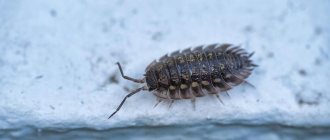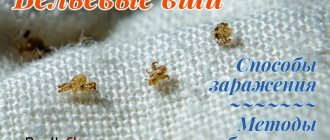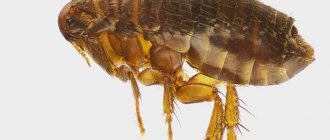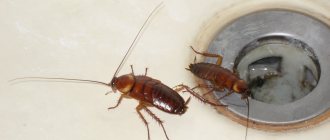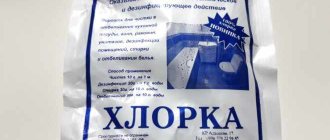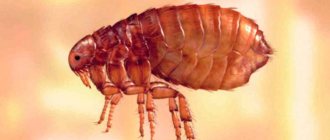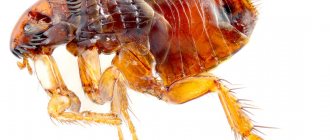SES 4 DEZ » Encyclopedia » Information about domestic fleas
In this material, prepared by the sanitary service specialists of SES 4 DEZ, you will find answers to the following questions:
- What do house fleas look like?
- What do fleas eat?
- How fleas reproduce;
- Where do fleas come from indoors?
- Where do fleas live in the house?
- Where do fleas live on the street?
- What do flea bites look like?
- Why are flea bites dangerous?
- Prevention against fleas;
- Methods for killing fleas.
If you wanted to call a health service to exterminate fleas, go to this page.
Fleas infest indoors by being carried by people or pets on their clothing or fur. They are quite difficult to notice due to their small size, but their presence can be clearly determined by their bites - they are very painful. At the moment, more than 2000 species of fleas are known, while more than 500 live in Russia.
Domestic flea in profile
What do fleas look like?
Fleas are wingless parasites that are reddish-brown in color. The average length of an individual is 2.5 mm, and can reach 4 mm in length. They have microscopic hair. The bodies are flat. Due to their 6 elongated legs, they can jump long distances - up to 33 cm in length. The claws located on the paws provide them with grip on the fur and body of animals. The mouthparts are of the piercing-sucking type.
It is quite difficult to kill a flea with a simple object or a clap of the palm due to their small size
Enemy specifics
Fleas multiply quickly and it is enough for one individual to appear so that in a short period of time there is a massive spread of blood-sucking insects. A flea can live alone for a long time, without a permanent place of residence in the form of skin.
The flea has a flattened body 5-7 mm long. There are many hairs and antennae on it, with the help of which it clings to skin and clothing. The color of fleas may vary in shade. It is usually maroon or black in color.
Fleas can jump to great heights. Three pairs of legs allow this trick to be performed. Sometimes jumps reach 2 meters in height.
Fleas leave bites on the body of animals and humans that cause severe itching. By biting, the flea sucks out blood, but before that it lets its saliva under the skin. It blocks blood clotting and the insect can feed without worrying that the blood will stop flowing. Such bites can provoke allergic reactions or even infection, since fleas are carriers of infectious diseases.
What do fleas eat?
Fleas are blood-sucking parasites. First of all, they prefer to feed on the blood of animals with thick hair - dogs, cats, rabbits, squirrels, rats, mice and other domestic and wild animals.
Despite the fact that fleas are divided by type depending on their food source (for example, cat fleas, dog fleas), all fleas bite people. During a bite, saliva is injected into the wound, which contains an analgesic substance, which prevents the immediate detection of the bite, but later irritation and itching appear.
Adults detect their victims by movement, vibrations and respiration (changes in heat and humidity in the air).
Fleas in a dog's fur
How long can an insect live without food?
Young animals that have just entered the adult stage must begin to feed within a week, otherwise they will simply die of starvation. In the most favorable climatic conditions, the individual survived for 2 weeks. It is also worth noting that insects at this stage are especially active in terms of feeding and cause much more discomfort to their host.
If the female has not previously fed on blood, then the life cycle of the newly emerged young increases noticeably - up to 30-40 days. In rooms with high humidity, this figure can approach 70 days. Similar conditions can be found in basements and attics of multi-story buildings. Whereas the parasite’s more familiar habitat – the fur of a pet and its bedding – is characterized by low humidity.
As soon as the flea finds a host, it begins to feed intensively. Literally within a day, the pest noticeably increases in size due to a good protein load. If the parasite is shed, then within 12-16 hours it loses its entire accumulated supply of proteins and decreases in size. After another 12 hours, due to lack of food, the insect may die.
If a flea has access to blood for about 2-3 hours a day, then this is considered malnutrition. For normal development, the insect needs periodic feeding. If a flea begins to feed from its owner, then after a while it develops a kind of drug addiction to the blood. A female fertilized on a carrier raises young animals that have already been planted on animal protein.
After 5 days of feeding on blood, shed fleas quickly die: females can last about 4 days, and males only 2 days . The survival rate of the parasite outside of a pet increases noticeably if it has fed on blood for no more than 12 hours, because the threshold for drug addiction has not yet been overcome.
How fleas reproduce
Fleas go through three stages of development: egg, larva, imago (adult). Going through all stages of the cycle takes from several weeks to several months. The speed of development depends on living conditions.
Egg
Flea eggs are also very small
Fleas lay eggs in waste and dust that accumulate in rooms, houses and animal beds. Unlike many other insects, fleas do not carry their offspring with them.
They lay two to thirteen eggs after eating. The female lays the largest number of eggs in the last days of her life. Unlike the eggs of other parasites, flea eggs are not sticky and simply fall to the ground after being laid.
The process of developing an egg into a larva takes about 12 days, with most eggs hatching within a few days.
Larva
Detection of larvae in places where dust accumulates is very difficult due to their size
Flea larvae are white transparent, from 3 to 5.2 mm in length. The body darkens as it absorbs food. The larvae have a worm-like appearance and molt twice during their life cycle. The larval stage can take up to 18 days, after which the larva is wrapped in a silky cocoon and enters the pupal stage. The pupal stage can be completed in three days or even last up to a year.
Unlike adults, larvae do not feed directly from the food source, but consume organic matter: food crumbs, dead skin, dead insects, pieces of fur, and primarily the excrement of adults - they contain undigested blood. The larvae are born blind and detect adults by their excrement, a sign that a food source is nearby.
After hatching from the egg, the larvae look for shelter - cracks, gaps and crevices in the floor, under furniture, and bed.
Imago (adults)
Adults move quickly through space until they find a food source
After hatching from the cocoon, adults begin searching for food sources. At first, they can be detected by moving around the apartment, but after detecting a food source (animal), they remain there. Females begin laying eggs within 48 hours of feeding, thus restarting the life cycle of future individuals.
Features of flea control
Fleas are wingless blood-sucking insects that can reach sizes up to 5 mm. Their body is flattened on the sides and has numerous spines and bristles. It is thanks to them that they have the ability to cling to clothing, including animal fur.
Fleas can even live on poultry, such as parrots. They are often found in the interwing space. In addition, fleas are able to live in burrows and nest substrates. With the help of three pairs of legs they can make significant jumps, which gives them the ability to move very quickly.
- It is incredibly difficult to crush a flea; it has a special flattened structure and a small head.
- With the help of long and strong legs, she is able to perform jumps up to 50 cm long.
- An adult insect is very tenacious; it can easily live without food for several weeks..
- The flea is distinguished by its high fertility, which ensures their rapid spread. One female can lay over a thousand eggs. After emerging from the cocoon, the female can be fertilized almost immediately. At the same time, just one meeting with a male is enough for her to subsequently lay eggs throughout her life. But for laying she needs fresh blood, as a result of which she will look for a victim.
Routes of infection
Fleas are brought indoors either by pets or by rats and mice, where they fall from dirt and leaves lying on the ground. Once indoors, they will settle on carpets, furniture, house plants, and draperies. A warm and humid habitat is ideal for them. Cold temperatures slow down their life cycle, so summer is the ideal time for them to reproduce and develop.
Fleas can also migrate from neighboring infested premises, from building basements and entrances.
Causes of fleas
Pet owners don’t have a question about why fleas appeared. However, there are known cases where parasites were found in homes where there are no pets and the owners keep them clean. There are many ways to infect an apartment with these insects. The most common causes of infection are:
Pets can bring in parasites from the street
Even if there are no pets, an infestation with brown bloodsuckers can occur. The carriers may be birds that live near the ventilation openings of houses, or those that have made nests near the windows of the apartment. Regularly flying onto a balcony or windowsill, birds drop adult individuals and their eggs, which then end up in the home.
The stairwells of apartment buildings, attics, and basements are habitats for a large number of insects. Jumping over the threshold with the door open is not difficult. If the residents of the house regularly visit basements and attics, then the question of why parasites have appeared disappears by itself.
Basements are a place from which you can bring fleas into your apartment.
Where do fleas live
Depending on the stage of development, fleas can be found in different places.
- The eggs are laid directly in the animal's fur, where they fall down carpets/upholstery/furniture/floor cracks in the floors and crevices in the walls. They go through their developmental stage in these secluded places, from where, having become an imago, they return to animals again.
- The larvae love narrow, inaccessible, dark and dusty places, which provide them with safety during their development. Flea pupae can only be found in the area of floors and carpets.
- Adults spend most of their time on food sources—animals with fur.
Video
Sources:
- Wade, SE & Georgi, JR Survival and reproduction of artificially fed cat fleas, Ctenocephalides felis Bouché (Siphonaptera: Pulicidae) // J. Med. Entomol. 25, 186–190 (1988)
- Kern, W.H., Koehler, P.G. & Patterson, R.S. Diel Patterns of Cat Flea (Siphonaptera: Pulicidae) Egg and Fecal Deposition // Journal of Medical Entomology 29, 203–206 (1992)
- Rust, M. K. Interhost movement of adult cat fleas (Siphonaptera: Pulicidae) // J. Med. Entomol. 31, 486–489 (1994)
- Hinkle, NC, Koehler, PG & Patterson, RS Host Grooming Efficiency for Regulation of Cat Flea (Siphonaptera: Pulicidae) Populations // Journal of Medical Entomology 35, 266–269 (1998)
- Dryden, M.W. Host association, on-host longevity and egg production of Ctenocephalides felis felis // Veterinary Parasitology 34, 117–122 (1989)
- Dryden, M. W. Biology of Fleas of Dogs and Cats // The Compendium on Continuing Education for the Practicing Veterinarian 15, 569–578 (1993)
Dmitry Lipchiu
Please rate the material
comments powered by HyperComments
Where do fleas live on the street?
Fallen leaves, grass in the shade under bushes and trees are ideal places to attack animals
Outdoors, fleas live in tall grass, sand, garbage and other places where they can find shelter and where there is sufficient moisture. Therefore, tall grass in the bush area is ideal for them to go through all three stages of development. In addition, animals often like to hide in the shade on hot days - exactly in those places where fleas live.
Habitats
Where do fleas live? Strong, hardy, these insects are common everywhere, even in cold
Antarctica, where they can successfully parasitize the same penguins and seals. Most of their species live in the temperate and subtropical zones of Europe, Asia, Africa, and the Americas. Fleas are active at any time of the year. They usually live near the nests and burrows of their potential donors: warm-blooded animals.
What do flea bites look like?
Externally, flea bites are similar in many ways to mosquito bites, but they take much longer to heal. Flea bites, unlike tick or ant bites, have only one puncture. Within half an hour, the bite site swells, turns red and itches very much. After one or two days, the area turns into a small wound or abscess and may even bleed.
What distinguishes flea bites from bedbug bites is their chaotic location.
Reproduction and development
Under favorable environmental conditions, fleas reproduce all year round. At extremely low temperatures, fleas will survive without problems, but will not reproduce. Also, for successful reproduction, both partners must be well-fed; hungry fleas will not reproduce.
During sexual intercourse, the female climbs onto the male's back and pulls his genital claw into her spermatic receptacle. Interestingly, sexual intercourse in fleas can last several hours, while it takes 10-15 minutes to transfer the seed to fertilize the female.
Some time after fertilization, the female lays eggs, which pass in small portions. Typically, fleas lay 1-2 servings of 4-10 eggs per day. The process of laying eggs itself is very curious: the female forcefully pushes out the eggs, which sometimes fly considerable distances from each other. This position of the eggs makes sense, since competition between the hatched larvae subsequently decreases.
Flea prevention
- regular examination of pets;
- regular brushing and washing of animals;
- regular inspection of the premises: carpets, draperies, furniture, animal beds, in rare cases - bed linen if you allow animals on the bed;
- vacuuming all hard-to-reach places, especially cracks and breaks in the floor, eliminating dust accumulations in the apartment;
- washing and drying animal bedding.
Cold living conditions lead to the fact that the larvae die without going through the pupation stage. Humidity below 45% will also cause death.
Preparing the apartment for flea treatment
Before treating the apartment, you need to find out where the fleas came from. If the source is not eliminated, then some time after disinfestation the parasites will reappear in the apartment. In an apartment building, fleas often migrate from the basement. In this case, you should contact the management company for help. She should hire a professional service to exterminate the ectoparasites. If the cause of fleas is a pet, special veterinary preparations will help clear its fur of fleas.
Recommended Links
Here you will find detailed instructions for preparing an apartment for flea treatment.
Preparing an apartment for flea treatment begins with general cleaning and treatment of textiles:
- Pet beds, blankets, toys, bedding and other items must be washed at high temperatures and treated with a steam generator or iron.
- Large items that cannot or cannot be washed should be dry cleaned.
- Thoroughly vacuum the carpet, upholstered furniture, baseboards, cracks, joints and openings.
- Clean out the pantry, get rid of unnecessary junk and old clothes.
- Treat cabinet shelves and furniture surfaces with a disinfectant solution.
You should free up space as much as possible from small objects, clear out cabinets and shelves. Only after this can you begin to disinfest the premises.
Methods for killing fleas
Fleas are resistant to most insecticides, but preparations containing fipronil, fluvalinate, cypermethrin, and cyfluthrin are effective. Also, to combat fleas, insecticidal preparations based on FOS (chlorophos, karbofos, fenthion), carbamate (propoxur), pyrethroids (permethrin, deltamethrin, cypermethrin, fenvalerate, cyphenothrin), neonicotinoids, etc. are used. A complete list of drugs used by our service for extermination fleas, written in simple language, can be found here. You can read instructions on how to kill insects yourself here.
To order the destruction of fleas in apartments and premises in St. Petersburg and the Leningrad region, call: 8
Are there fleas in the house?
The first evidence of the presence of insects will be bites. Small redness in the form of dots on the legs and arms indicate the presence of fleas in the apartment. The bites are closely spaced and very itchy. But, even without detecting obvious traces, you can conduct a series of experiments that will confirm or refute the proximity to fleas.
After collecting dust after cleaning, you need to dissolve it in water. If the liquid turns pink, it means there are fleas in the apartment. The color of the water is due to the fact that flea feces contain remnants of eaten blood.
Sweet water or honey will attract fleas. The container with honey can be left overnight on the floor. In the morning, trapped individuals will definitely be found in it. If the plate is clean, then there are no fleas in the house.
Myths about flea lifespan
Among this type of insect, there are also real long-livers that parasitize ungulates. Tien Shan fleas reach sizes of up to 7 mm and can live for a year. Parasites in the northern regions often go into a kind of hibernation for the winter, but remain active for no more than 1.5 years. As for the more familiar types of fleas on dogs, cats and other animals, it is necessary to dispel several established myths.
Experts have long noticed that such pests cannot constantly be present on humans or other mammals. It seems to many that the insect’s usual habitat is the fur of a domestic animal, but in such an environment there are no suitable conditions. Fleas need to develop and reproduce calmly and comfortably, and the victim’s body is completely unsuitable due to numerous risks.
The parasite jumps onto the selected individual and begins to look for a suitable area to suck blood. A kind of banquet can last from a minute to several hours. After the meal, the insect jumps off and returns to its usual habitat. Due to the huge number of pests in the fur of a cat and dog, it seems that the flea does not leave the poor animal.
Taking into account such factors, when disinsection it is necessary to carefully search for insect breeding locations. Carefully inspect the following places in the apartment:
- Animal bedding;
- Skirting boards;
- Carpets;
- Floor cracks;
- Garbage bins;
- Old trash.
Pests rarely live in clothes, but if the area is highly infested, it is necessary to inspect the closet. The parasite feels especially comfortable when the source of food is freely available.
Don’t be surprised where a domestic cat gets fleas, because often people themselves bring several females of the pest from the street.
Like a number of other bloodsuckers, fleas are capable of spending long periods of time without food. For several months, the tiny creatures starve and do not hibernate. Regardless of life expectancy, an insect will not be able to reproduce without periodic reinforcement. This is why females become especially aggressive and try to drink more blood. In practice, we can give the following example: after a long stay, fleas will not die in your apartment and will begin to bite painfully immediately after the owners arrive.
On shelves and cabinets
Cat owners know that sometimes their pets can easily jump to the very ceiling. Therefore, the presence of fleas on bookshelves, kitchen furniture and other high places should not be surprising. Remember that flea eggs fall everywhere where your furry friend moves.
Forecast for solving the problem
Removing fleas on your own can take a very long time. It is worth considering that most household insecticides do not act on their eggs, and in the case of developed resistance, even on adults. The whole cycle will repeat again and again ad infinitum. If the number of insects is so large that the entire apartment is infected, then the use of a highly toxic insecticide cannot be done 100%, and, as mentioned above, it is not a fact that its one-time use will be enough (even with professional help).

